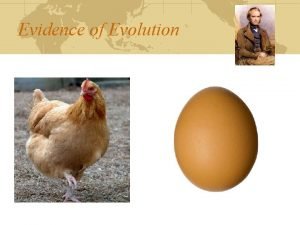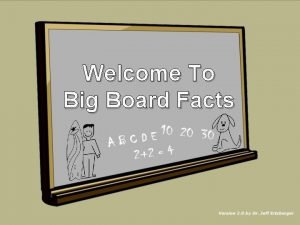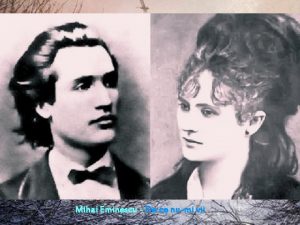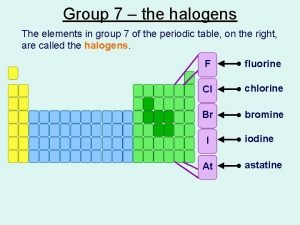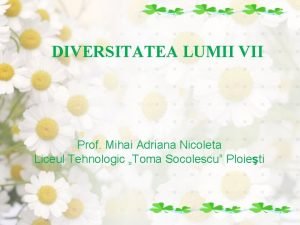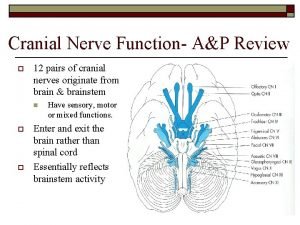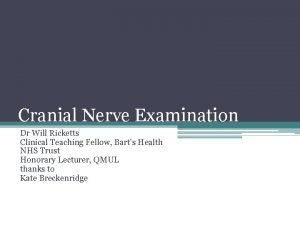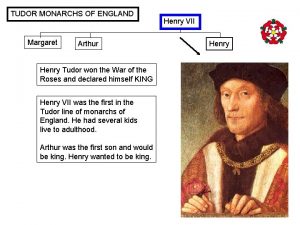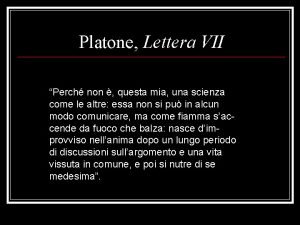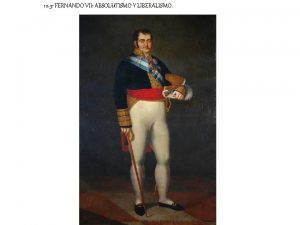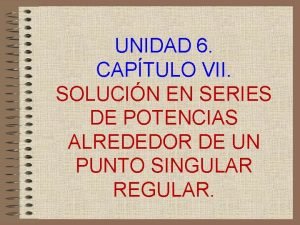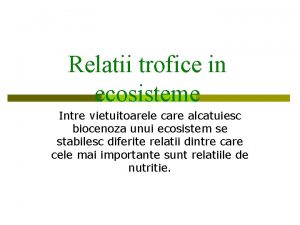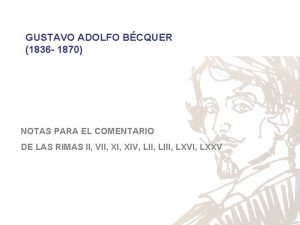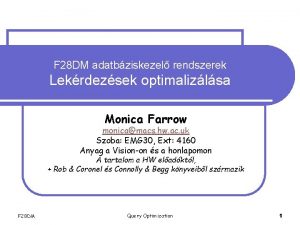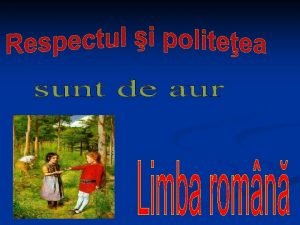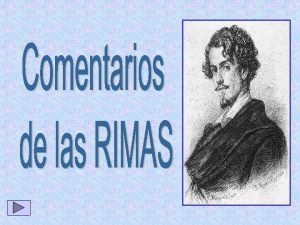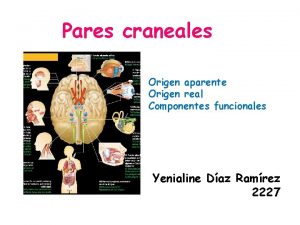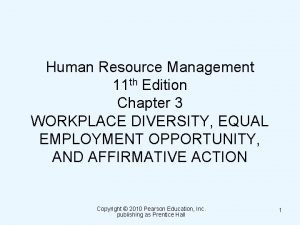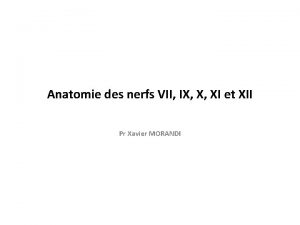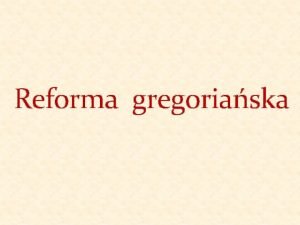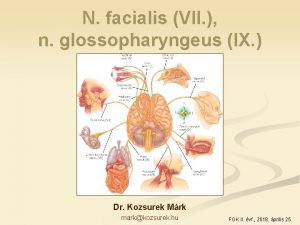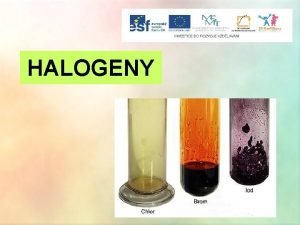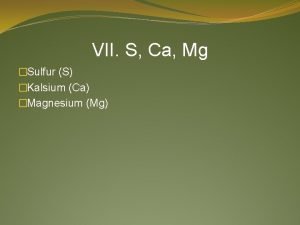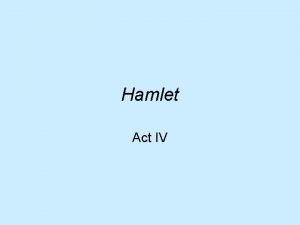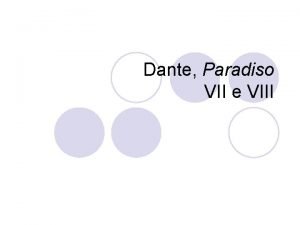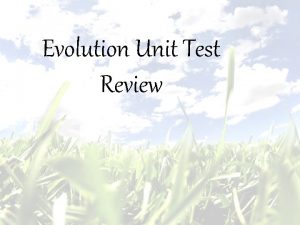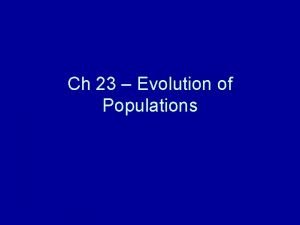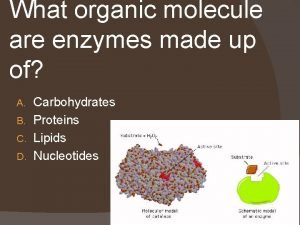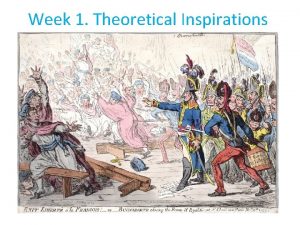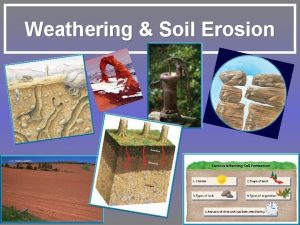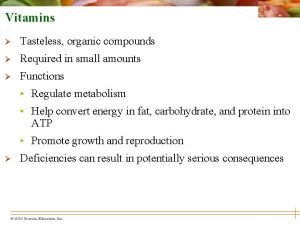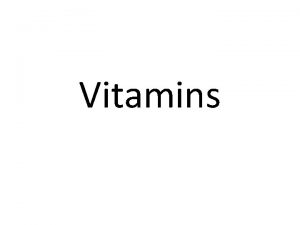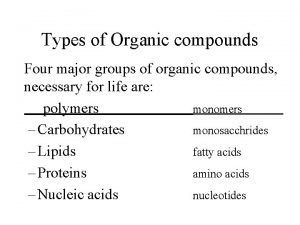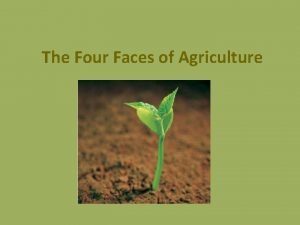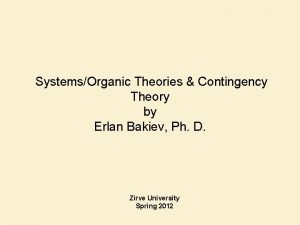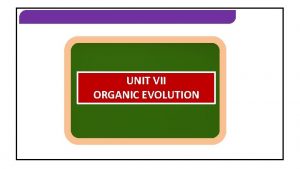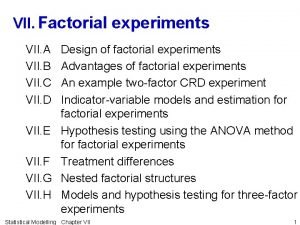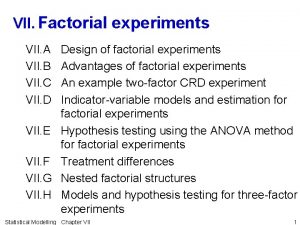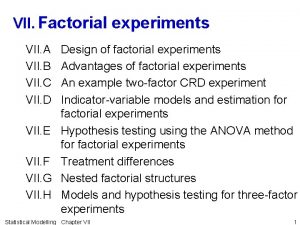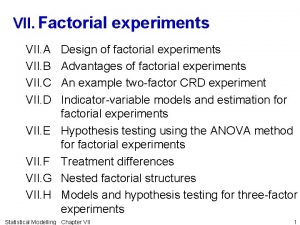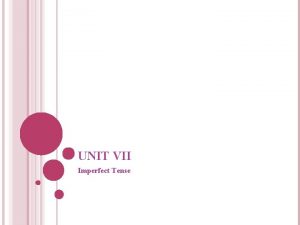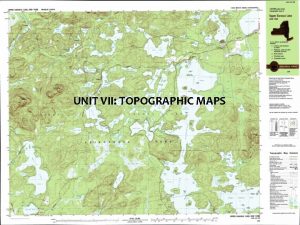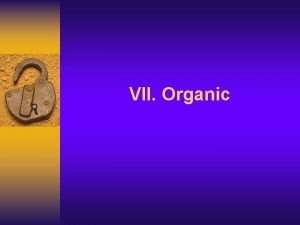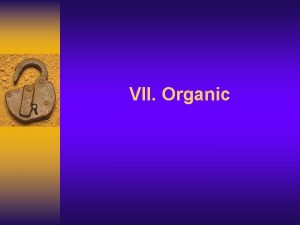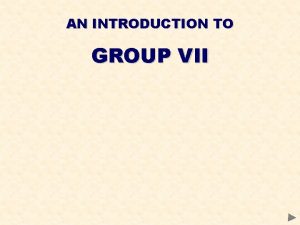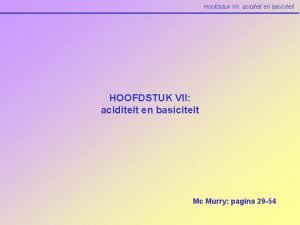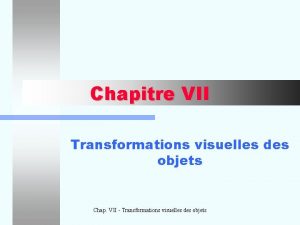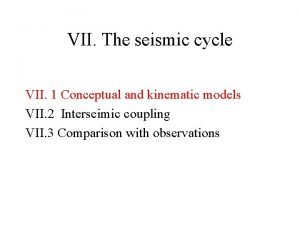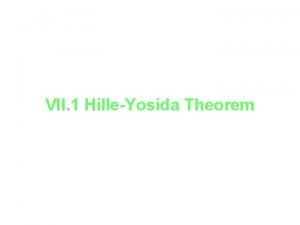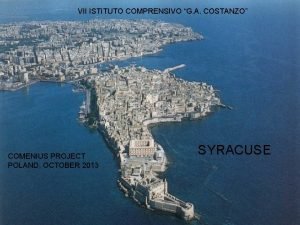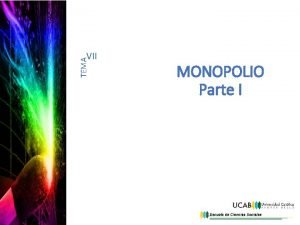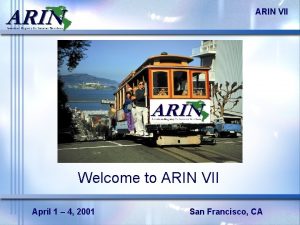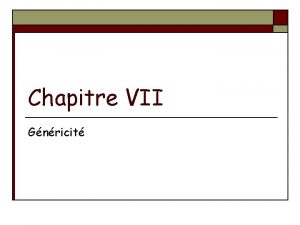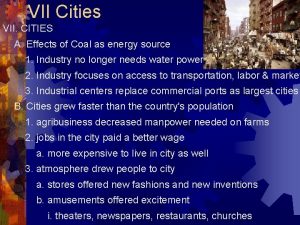ORGANIC EVOLUTION UNIT VII ORGANIC EVOLUTION ORGANIC EVOLUTION










































































- Slides: 74

ORGANIC EVOLUTION UNIT VII ORGANIC EVOLUTION

ORGANIC EVOLUTION

ORGANIC EVOLUTION Theories of Evolution • • According to him, whenever the environment of certain organisms Inheritance It deals with…. Lamarckism Influence ofof undergoes some changes, it forces organisms usethe or disuse of to use certain acquired environment • It was more explained bycertain Jean other Baptiste de to Lamarck, organs and put organs disuse. in his book organs characters Philosophie Zoologique. Lamarck

ORGANIC EVOLUTION The organs that are used more will increase in size and those not used continuously will degenerate. Elongation of neck that are Such characters anddeveloped forelimbsduring in the life giraffetime (use), absence of an organism are ofcalled limbs acquired in snake characters. (disuse). Acquired characters are passed on to the next generation.

ORGANIC EVOLUTION Objection The main objection for Lamarckism came from Augustus Weisman

ORGANIC EVOLUTION Objection • He conducted decaudalisation experiments on rats and proposed that the bodies of all the living organisms posses somatoplasm and germplasm. Weismann collected two rats and cut their tails. crossed Reproductive Body cells such tail less (acquired character) rats and observed the cells progeny. He got the tailed progeny. He repeated the experiment (cutting of tails, crossing and observation of progeny) upto 22 generations. Weismann did not get not even a single rat with out tail.

ORGANIC EVOLUTION Objection If any change occurs in the somatoplasm, it will not be transferred to the next generation.

ORGANIC EVOLUTION Objection If any change occurs in the germplasm, it will be inherited by the next generation.

ORGANIC EVOLUTION e. g. 1. Well developed muscles of athletes are not inherited to the children. 2. Making perforations to pinna for wearing ornaments is not inherited.

ORGANIC EVOLUTION Neo-Lamarckism The contributions of Lamarck paved the way for the gradual acceptance of the concept of biological evolution. • The followers of Lamarck (Neo- Lamarckists) like…. Cope Osborn Packard Spencer

ORGANIC EVOLUTION Neo-Lamarckists considered that Adaptations are universal. • Organisms acquire new structures due to their adaptations to the changed environmental conditions. They argue that external conditions stimulate the somatic cells to produce certain ‘secretions’ which reach the sex cells through the blood. Such variations can be inherited.

ORGANIC EVOLUTION • Paul Kammarer observed the development of normal eyes and skin colour in the cave dwelling Salamander, Proteus anguinus, when exposed to daylight. This somatic character was passed to next generation. Salamander Proteus anguinus

ORGANIC EVOLUTION Darwinism It is an evolutionary theory proposed by Charles Robert Darwin(1809 -1882).

ORGANIC EVOLUTION Darwinism • He was much influenced by three publications…. The on tendency of “An Essay the Sir Charles Darwin published his by Lyell Alfred principle varieties of Population” entitled theory in his book titled“principle Russell Wallace. of Thomas Malthus. of Geology” “The Origin of Species” by means of Natural Selection.

ORGANIC EVOLUTION Theory of Natural Selection • Darwin's theory of natural selection does not explain what exactly evolution is, but explains how evolution might have occurred in nature. • His theory was based on… • Several facts • Observations • Inferences

ORGANIC EVOLUTION i. Prodigality of Production or Over Production ii. Constancy in population iii. Struggle for existence. 1. Intra-specific struggle 2. Inter-specific struggle 3. Struggle with the environment iv. Universal occurrence of variations v. Natural selection vi. Origin of species Theory of Natural Selection

ORGANIC EVOLUTION i. Prodigality of Production or Over Production • Every organism tends to increase its population in large proportions.

ORGANIC EVOLUTION i. Prodigality of Production or Over Production e. g. Paramecium divides by binary fission at the rate of three to four times a day. At this rate, the volume of all the Paramecia equals to 10, 000 times that of the earth at the end of the 9000 the generation.

ORGANIC EVOLUTION • Salmon fish produces 28 million eggs and starfish one million eggs in a season. If all of them hatch and the larvae grow to reproductive age, all the seas will be filled with them in a few generations.

ORGANIC EVOLUTION • Even the slowest breeder, the elephant can produce 19 million descendants at the end of the 800 th generation in the absence of any check.

ORGANIC EVOLUTION ii. Constancy in population An abnormal increase is noticed in the population of any species in nature as the offspring die in large numbers before reaching the reproductive age. It is true that the food and the other sources do not increase in the same proportion as that of the population.

ORGANIC EVOLUTION iii. Struggle for existence 1. Intra-specific struggle Competition due to food & Space Constraint 3. Struggle with the environment 2. Inter-specific struggle

ORGANIC EVOLUTION 1. Intra-specific struggle • It is for food, shelter and mate. • It is the most severe check on the rate of reproduction. Competition among the individuals of the same species.

ORGANIC EVOLUTION 2. Inter-specific struggle • • Competition between Most of the species have the same type of food habits. the organisms of Hence, competition exists among them chiefly for food and shelter. different species living together.

ORGANIC EVOLUTION 3. Struggle with the environment Struggle of all living forms against adverse environmental conditions like Natural Calamities, drought, storms, earthquakes etc.

ORGANIC EVOLUTION iv. Universal occurrence of variations • No two organisms are exactly similar. • They show variations. Variations Favourable Unfavourable Useful Variations Differences The useful and are preserved between variations an passed onhelp to their individuals of the organism to offsprings. same species overcome struggle.

ORGANIC EVOLUTION V. Natural selection The individuals possessing harmful • According to Darwin variations arethe ability to The organisms with beneficial variations would increase reproduce and leave more fertile offspring. reproductively less successful. They are said to be the ‘fittest organisms’ and they can only survive.

ORGANIC EVOLUTION • Organisms with favourable mutations succeed in the Struggle for Existence. This is called the Natural Selection. Herbert Spencer called this phenomenon as ‘survival of the fittest’ Herbert Spencer

ORGANIC EVOLUTION vi. Origin of species Struggle for existence variability & inheritance Organisms tend to become more adapted to their environment In every generation there is a slight A newbetterment species originates of the by the gradual already developed accumulation of characters favorable variations for a number of generations.

ORGANIC EVOLUTION Such an accumulation over a long period of time brings so many changes in an organism that it does not interbreed any more with the original parental species. reproductively Darwin considered that. Aformation of a new organism species is due to the isolated cumulative effectis of ‘fluctuating variations’. considered a new species

ORGANIC EVOLUTION 1. Lamarck explained his concept of the formation of new species in his book… 1) Philosophie Zoologique 2) Origin of species 3) Principles of Geology 4) The principles of population MCQS

ORGANIC EVOLUTION 2. Lamarck cited the example of giraffe to explain. … 1) Disuse of an organ 2) Misuse of an organ 3) Use of organ 4) Vestigial organ

ORGANIC EVOLUTION 3. The term mutation was coined by… 1) Hugo de vries 2) Darwin 3) Bateson 4) T. H Morgan

ORGANIC EVOLUTION 4. The theory proposed by August Weismann. …… 1) Biogenesis theory 2) Germplasm theory 3) Sexual selection theory 4) Biogenetic law

ORGANIC EVOLUTION

ORGANIC EVOLUTION II. Objections to Darwinism Explains Survival of the fittest No satisfactory explanation for the cause, origin & inheritance of variations No idea about inheritance of useless variations like the vestigeal organs But not the arrival of the fittest

ORGANIC EVOLUTION • It focused on small, fluctuating variations which are mostly non-heritable. • It did not distinguish germinal variations. between somatic and

ORGANIC EVOLUTION • Alfred Russell Wallace, a British naturalist, who worked in Malaya Archipelago, had also come to the conclusion similar to those of Darwin, around the same time.

ORGANIC EVOLUTION Experimental verification of natural selection-industrial melanism: Natural selection is the classical case of industrial melanism, exhibited by peppered moth-Biston betularia. Bernard Kettle well, a British ecologist, tested this hypothesis experimentally.

ORGANIC EVOLUTION These moths were available in two colors, grey and black. Ø During the industrial revolution, the black forms were more and the grey forms were less in the industrial cities like Birmingham. Prior to industrial revolution, the grey moths were abundant.

ORGANIC EVOLUTION Biston betularia Both forms fly during night Both forms rest on trees during the day Differ by only one allele of the gene forming dark pigment (melanin)

ORGANIC EVOLUTION Prior to Industrial revolution Pre 1800 s Light forms were common throughout Britain Dark arose by random mutation-very rare

ORGANIC EVOLUTION Light peppered moths In non-polluted areas tree trunks covered with pale coloured lichens Moth camouflaged well against pale background Dark forms easily seen & eaten by predators

ORGANIC EVOLUTION Survey in the 1950 s Pale form most abundant in non -industrial areas Dark forms most abundant in areas suffering from heavy air-pollution

ORGANIC EVOLUTION Reason for change? In polluted areas -toxic gases kill lichen -soot particles darken tree trunks Dark coloured can hide well and favoured by natural selection the Light coloured moth easily seen

ORGANIC EVOLUTION • • Bernard Kettlewell, a British ecologist, tested this hypothesis experimentally. He released them in two sets of equal numbers; one set selection in Birmingham, a Thus Natural has resulted polluted urban area, and the other in theboth establishment of a set Collected the grey in Dorset, an unpolluted area. phenotypic trait rural inofchanging and the black forms environmental Biston betularia forconditions his experiment.

ORGANIC EVOLUTION • • Those recaptured from Birmingham, there were After amoths few days he recaptured them. more black forms. Among those recaptured from Dorset there were more grey forms. The reason for such a difference is: the melanic forms could not be easily spotted by predator birds as their body colour merged with the dark colour of the bark of trees in Birmingham area.

ORGANIC EVOLUTION • In the rural areas (Dorset) the grey forms had better survival chance as their body colour merged with the light coloured surroundings. • It will be interesting to know that there was a reversal in the selection process after the introduction of pollution check laws in the urban areas.

ORGANIC EVOLUTION Mutation Theory Mutations are sudden, random, inheritable changes that occur in organisms. This was proposed by Hugo de Vries, a Dutch botanist, who coined the term “mutation”.

ORGANIC EVOLUTION He found four different forms in Oenothera lamarckiana. (commonly called evening primrose) Oenothera lamarckiana

ORGANIC EVOLUTION • O. brevistylis- small style • O. levifolia – smooth leaves • O. gigas – the giant form • O. nanella- the dwarf form (mutant varieties).

ORGANIC EVOLUTION T. H. Morgan studied the inheritance pattern of mutations in Drosophila melanogaster. Darwin called mutations (large variations) sports of nature or saltations, whereas Bateson called them discontinuous variations.

ORGANIC EVOLUTION Salient Features of Mutation theory i) Mutations occur from time to time in naturally breeding populations. ii) They are discontinuous and are not accumulated over generations. iii) They are full-fledged, and so there are no ‘intermediate forms’. iv) They are subjected to Natural Selection.

ORGANIC EVOLUTION 1. Darwin theory could not explain… 1) Mechanism by which variations occur MCQS 2) Occurrence of vestigial organs 3) Did not distinguished between somatic and germinal variations 4) All the above

ORGANIC EVOLUTION 2. Mutation theory proposed by. … 1) Bernad sheh 2) Stephens 3) Hugo de vries 4) T. H morgan

ORGANIC EVOLUTION 3. Inheritance pattern of mutations studied by T. H morgan… 1) Yeast 2) Drosophila 3) Evening prime rose 4) None of these

ORGANIC EVOLUTION

ORGANIC EVOLUTION Weismann’s germplasm theory, de Vries’ mutation theory and Mendel’s laws of inheritance helped a lot in understanding the origin and inheritance of variations. Supported The theory of Darwinism. Huxley Haeckel Simpson

ORGANIC EVOLUTION v Later Fisher, Sewall Wright, Mayr explained Natural Selection in the light of post-Darwinian discoveries (Synthetic theory/Genetical theory/Neo-Darwinism). Fisher Sewall Wright Mayr

ORGANIC EVOLUTION v According to this theory, five basic factors are involved in the process of organic evolution. They are Gene mutations Reproductive isolation Chromosomal mutations Synthetic Theory Natural Selection Genetic recombinations

ORGANIC EVOLUTION (i) Gene mutations They alter the phenotypic characters of the individuals.

ORGANIC EVOLUTION v Changes in the structure of a gene (DNA molecule) are called gene mutations or point mutations. v Thus, gene mutations tend to produce ‘variations’ in the offspring.

ORGANIC EVOLUTION (ii) Chromosomal mutations v Changes in the structure of chromosomes (due to deletion, addition, duplication, inversion or translation) are called chromosomal mutations. Ø Chromosomal deletion Ø Chromosomal addition Ø Chromosomal duplication Ø Chromosomal inversion

ORGANIC EVOLUTION Chromosomal addition Chromosomal deletion

ORGANIC EVOLUTION Chromosomal inversion Chromosomal duplication

ORGANIC EVOLUTION (ii) Chromosomal mutations bring about variations in the phenotype of organisms. These led to the occurrence of variations in the offspring.

ORGANIC EVOLUTION (iii) Genetic recombinations v Recombinations of genes due to crossing over during meiosis are also responsible for bringing about genetic variability among the individuals of the same species.

ORGANIC EVOLUTION (iii) Genetic recombinations Genetic re-combinations contribute to the occurrence of heritable variations.

ORGANIC EVOLUTION (iv) Natural Selection does not produce any genetic changes in the organism. Driving force of evolution Once the genetic changes occur, it favours some genetic changes while rejecting others.

ORGANIC EVOLUTION (v) Reproductive isolation The absence of gene exchange between population is called the reproductive isolation. Preserves the species integrity. It plays a great role in giving rise to new species.

ORGANIC EVOLUTION 1. Natural selection by Modern Synthesis or Neodarwinism was explained by… 1) R. A Fisher 2) Sewall wright 3) Ernst mayr 4) All the above MCQS

ORGANIC EVOLUTION 2. The factors involved in the process of organic evolution according to synthetic theory. … 1) Gene mutations 2) Chromosomal mutations 3) Genetic recombinations 4) All the above

ORGANIC EVOLUTION 3. Changes in the structure of DNA molecule are called… 1) Mutations 2) Atavism 3) Gene mutations 4) None of these

ORGANIC EVOLUTION Thank you…
 Unit 10, unit 10 review tests, unit 10 general test
Unit 10, unit 10 review tests, unit 10 general test Wikipeda
Wikipeda Tetraphosphorous decasulfide formula
Tetraphosphorous decasulfide formula Fernando vii
Fernando vii Reach annex vii
Reach annex vii De ce nu-mi vii de mihai eminescu
De ce nu-mi vii de mihai eminescu Pedagogik fikrlar va maktablar tarixi
Pedagogik fikrlar va maktablar tarixi Hallogen group
Hallogen group Diversitatea lumii vii notiuni introductive
Diversitatea lumii vii notiuni introductive Cranial nerve to smile
Cranial nerve to smile So4 lr6
So4 lr6 Henryk vii tudor
Henryk vii tudor Mamiferele se înmulțesc prin ouă
Mamiferele se înmulțesc prin ouă Monarchs of england
Monarchs of england King henry vii family tree
King henry vii family tree 100 people surveyed
100 people surveyed Lettera vii platone
Lettera vii platone Nerf facial trajet
Nerf facial trajet Song vii by rabindranath tagore
Song vii by rabindranath tagore 6/1996. (vii. 16.) müm rendelet
6/1996. (vii. 16.) müm rendelet Article x the teacher and business
Article x the teacher and business 10/2015 (vii. 30) hm
10/2015 (vii. 30) hm Fernando vii absolutismo
Fernando vii absolutismo Vii=i solucion
Vii=i solucion Relatii intre vietuitoare
Relatii intre vietuitoare Keputusan menteri kesehatan ri nomor 829/menkes/sk/vii/1999
Keputusan menteri kesehatan ri nomor 829/menkes/sk/vii/1999 Hikayat hang tuah bab 4
Hikayat hang tuah bab 4 Rima vii becquer comentario
Rima vii becquer comentario F
F Dante's inferno canto 7
Dante's inferno canto 7 Soarele de dupa vii isi arata fata
Soarele de dupa vii isi arata fata Define handouts
Define handouts Yo te vii
Yo te vii Rima xxix
Rima xxix V par craneal origen real y aparente
V par craneal origen real y aparente Title vii of the civil rights act
Title vii of the civil rights act Cranial vii
Cranial vii Title vii of the civil rights act
Title vii of the civil rights act Nerf facial
Nerf facial N tympanicus kimin dalı
N tympanicus kimin dalı Reforma gregoriańska
Reforma gregoriańska Ten-tec omni vii problems
Ten-tec omni vii problems Crus longum
Crus longum Vii. a skupina
Vii. a skupina Vii. a skupina
Vii. a skupina Group 7 halogens
Group 7 halogens Vii s
Vii s Vii informe foessa
Vii informe foessa Reakcja utleniania etanolu za pomocą manganianu
Reakcja utleniania etanolu za pomocą manganianu Hamlet act iv scene iii
Hamlet act iv scene iii Canto viii paradiso
Canto viii paradiso Fragment 2 for composition vii, 1913.
Fragment 2 for composition vii, 1913. Evolution unit test
Evolution unit test Biology unit 10 quiz 2
Biology unit 10 quiz 2 Why are populations the smallest unit of evolution
Why are populations the smallest unit of evolution Suatu lembaga yang
Suatu lembaga yang Right triangle trigonometry
Right triangle trigonometry English system of measurement
English system of measurement Algebra 2 unit 1 practice test
Algebra 2 unit 1 practice test Contoh unit cost rekam medis
Contoh unit cost rekam medis Unit process and unit operation
Unit process and unit operation Unit operation and unit process
Unit operation and unit process Kerangka konseptual akuntansi pemerintahan
Kerangka konseptual akuntansi pemerintahan Enzymes are composed of what organic molecule
Enzymes are composed of what organic molecule Gail model sociology
Gail model sociology Organic solidarity
Organic solidarity The rate of weathering depends upon the area's ____
The rate of weathering depends upon the area's ____ How are vitamins absorbed
How are vitamins absorbed Vitamin flowchart
Vitamin flowchart Founder of organic chemistry
Founder of organic chemistry The four major groups of organic compounds are
The four major groups of organic compounds are Organic solidarity
Organic solidarity Pros and cons of organic farming
Pros and cons of organic farming Organic organization characteristics
Organic organization characteristics Swo analysis
Swo analysis

